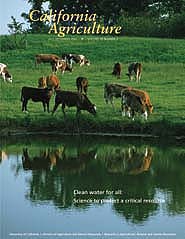Calag Archive
Calag Archive

Clean water for all: Science to protect a critical resource
Cover:
Almost all of California's surface water passes through the state's 57 million acres of rangeland. Ranch water-quality plans are aimed at limiting levels of sediment, pathogens, heat build-up and nutrients in streams. Careful management informed by state-of-the-art science, can minimize nonpoint source solution attributed to cattle grazing. Stock image from Corbis .
July-September 2004
Volume 58, Number 3
Volume 58, Number 3


